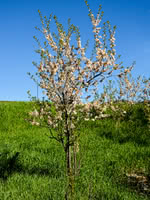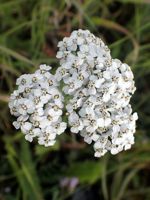Mon-Fri 9am - 5pm Mountain time
Canada Plum & American Plum vs Yarrow
Prunus nigra and americana
Achillea borealis (Previously Achillea millefolium)
NOT AVAILABLE THIS SEASON
(new stock expected: fall of 2026)
Canada and American Plum are almost identical in appearance and growth needs. These plants are short and stout fruit trees native to North America.
This hardy ornamental is excellent for both city dwellings as well as rural areas. During the spring, the white and pink blossoms are long lasting. The tasty fruit is suitable for fresh eating, baking, and preserves. These trees are not widely distributed and pure seed can be hard to come by.
Both are commonly used as rootstock and are considered universal pollinizers for other plum varieties.
Yarrow is a herbaceous, native wildflower that is found across Canada. It features large, flat clusters of tiny white flowers. The blooms attract a variety of pollinators, making it an ideal choice for pollinator gardens. While partial shade is tolerated, the best flowering occurs in full sun. Yarrow is resistant to deer and rabbits, making it both a beautiful and practical addition to your landscape.
The entire plant is edible, but leaves and flowers are most commonly consumed. They have a strong licorice scent and a mild sweet flavor that is similar to tarragon. Yarrow leaves can also be used as a natural insect repellent.
It is important to plant Yarrow in the right place, it can spread quickly via both rhizomes and self-seeding. Deadheading the spent flowers will extend the bloom season and can help limit self-seeding.
Canada Plum & American Plum Quick Facts
Yarrow Quick Facts
Toxicity: toxic to dogs, cats, and horses

